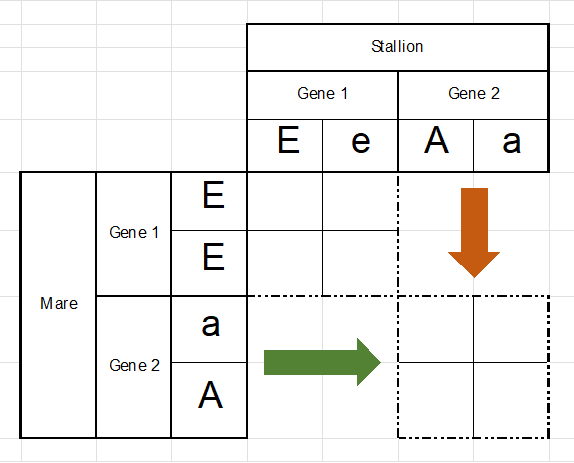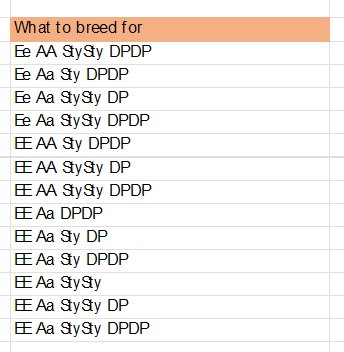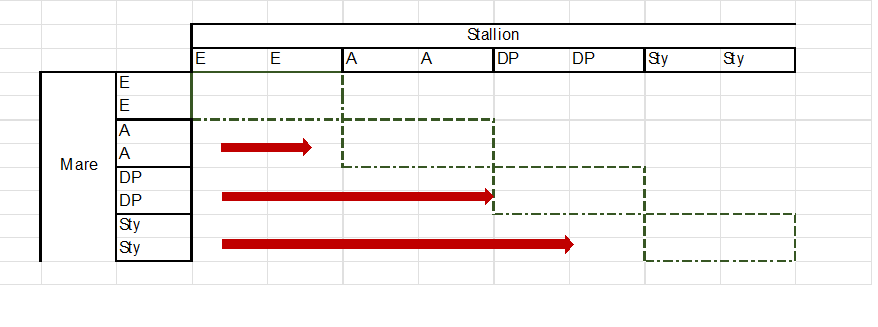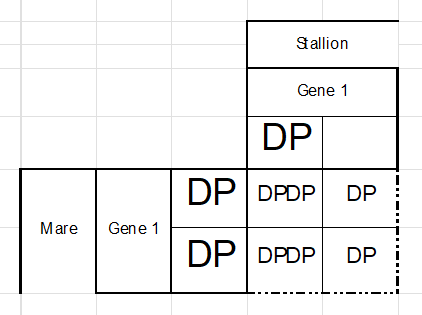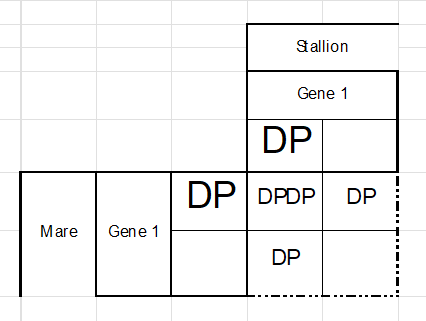Planning a Breeding: How to Use a Punnett Square
If you've been following along with this wiki, at this point you should have a basic understanding of genetics and what each gene does. As HAJ is a game where you play how you want, now you can figure out what you want to breed for. But wait! Maybe it's a very specific genetic combination that can only have a few possible outcomes. If that's the case, punnett squares are your best friend.
In this example, the genetic combination(s) for Brown will be shown. The punnett squares shown have been made in Excel and are really easy to make.
Shown below is a punnett square made for 2 of the important genes to create a Brown color. Each gene you want to specifically breed for, you will need its own punnett square.
Gene 1 (the E, or black gene) from both the mare and stallion has its own; and Gene 2 (the A, or agouti gene) has another. As the subsection on punnett squares showed you, a copy of the letter from each gene from each parent will go into one of the squares.
Agouti and the Black genes will ALWAYS have 2 copies as they are the building blocks of horse colors.
In this example, the 4 boxes on Gene 1 will look like this, starting from the top left to top right, then bottom left to bottom right: EE, Ee, EE, Ee.
In the punnett square for Gene 2, the 4 boxes will look like this: aA, aa, AA, Aa.
As you may have noticed, aA and Aa are exactly the same, just in reversed order. They both read as Aa, as the A is more dominant than a. When you create your own punnett squares for your own breeding goals, enter your horse's genes exactly as they are to avoid any confusion.
Gene Sequencing
What these 8 boxes show you are the possibilities of a foal's genotype (or the letters seen in your horse's Genetic Testing Results section) for each gene. With this example, there are 32 possible outcomes (8 boxes x 4 traits).
The game has recently updated its agouti gene to only have 2 alleles - A and a, which for some, makes breeding for Brown horses much easier. These 2 genes are not the only ones necessary for breeding Browns, so all possible outcomes have been shown in the picture below.
Going back to the example above, your 2 genes are:
EE Ee EE Ee
Aa aa AA Aa
Comparing these to the list above, these genes will have a really good chance of producing a Brown foal, depending on the genes for the Sooty (Sty), and DP (Dense Pheomelanin) genes. A punnett square to check for all 4 genes will look something like this:
From here, you can now fully utilize a punnett square for your breeding goals, to see how good of a chance you have at breeding exactly what you want. This picture shows the absolute best possible genes for successfully continuing a Brown horse project
Heterozygous Genes
In the case of heterozygous genes (or genes with 1 copy), such as Sooty or Dense Pheomelanin (DP), the punnett square will look slightly different. There won't be 4 sets of letters in each box.
Sooty and Dense Pheomelanin only need 1 copy to show.
In the picture above, the stallion has only 1 copy of the DP gene, whereas the mare has 2 copies. As you can see, in the 2 left boxes, there are 2 copies of the DP gene, but only 1 copy in the right boxes. The resulting foal will still show DP in their genetic results, but will only have a 50% chance of having 1 or 2 copies.
But Wait! What If Both Horses Are Heterozygous For The Gene?
If both parents have only 1 copy of your desired gene, again, the punnett square will look different. This time, only 3 of the 4 boxes will be filled out, as shown below.
In this case, you will only have a 25% chance of getting a homozygous (or both copies) gene, a 50% chance of getting a heterozygous gene, and now a 25% chance that the gene won't pass on!
In breeding terms, this does not give you very good chances on the foal - yes, you have a 75% chance the foal will have DP, but 50% of that is 1 copy and becomes another slim chance for a future foal. Your best bet when it comes to breeding for your desired traits/genes, is to have at least 1 homozygous parent breeding. Both parents being homozygous is your best bet!
And that is how you plan a breeding! Just remember to create a punnett square for each gene you want to breed for! ^_^

